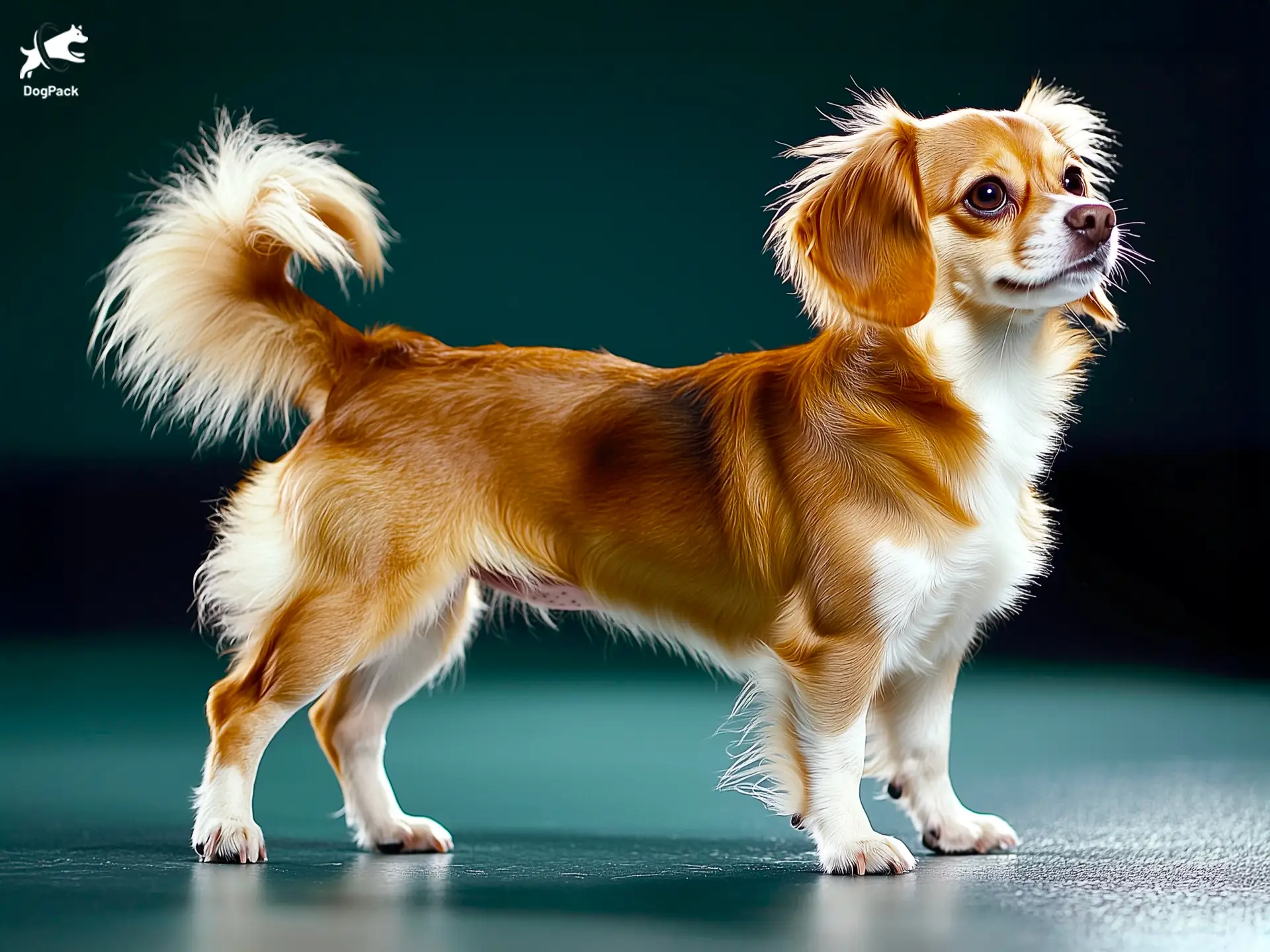Pomeagle Dog Breed Info & Overview
Standing out as a delightful cross between the beloved Pomeranian and the steadfast Beagle, the Pomeagle offers a one-of-a-kind personality and look. Known for a lively spirit and a curious mind, they often charm families who crave a playful yet cuddly companion. They adapt well to various home setups, making them a truly inviting addition to the right household.
Characteristics
Pictures
Breed History
The path of the Pomeagle began when breeders aimed to blend the upbeat, fluffy nature of a Pomeranian with the keen nose and hunt-driven background of a Beagle. Though not officially recognized by major kennel clubs, these spirited pups have gained traction over the last two decades. Their roots trace back to the United States, where dog enthusiasts experimented with mixing smaller breeds to create fun-loving, family-friendly companions.
Originally, Beagles were prized for their exceptional scent-tracking skills, accompanying hunters on expansive grounds. Pomeranians, however, were more known for their lapdog qualities and big personalities in tiny bodies. It’s no surprise that combining these two lines produced a pint-sized bundle of curiosity and affection. Each parent’s history contributed unique traits, molding a hybrid that offers both alertness and an eagerness to please.
Despite their relatively new status in the canine world, this cross quickly became recognized among those who appreciate both intelligence and a playful edge. Owners typically find that the Pomeagle retains enough of its Beagle ancestry to relish outdoor escapades, while the Pomeranian influence lends a cuddly, entertaining nature. Over time, these dogs found their niche as adaptable companions, suited for a wide variety of lifestyles.
Temperament, Personality
This mix radiates curiosity and warmth, often greeting family members with exuberant tail wags and a bright-eyed gaze. While they love to romp around the house or yard, they also enjoy curling up on a cozy sofa when the day’s adventures wind down. Above all else, they thrive on interaction with their human companions, soaking up affection with a joyful spirit.
With children, the Pomeagle tends to be affectionate and playful, though supervision is always wise given their smaller frame. Many owners report that these pups form tight bonds with kids, matching the family’s energy level when it’s time to play. Their gentle side appears when they sense calm, making them equally adept at snuggling quietly after a long day of excitement.
When meeting new people or animals, they generally exhibit a friendly curiosity. Occasionally, shyness might emerge if they haven’t been socialized early, but consistent exposure to different environments typically results in a well-rounded dog. While they retain an alertness from their Beagle side, they’re unlikely to be aggressive, preferring playful investigation over displays of dominance or fear.
Physical Characteristics
At first glance, you’ll notice a compact body, standing somewhere between a typical Pomeranian’s daintiness and a Beagle’s sturdiness. Their faces often resemble the Beagle side, complete with expressive eyes and a slightly pointed muzzle. The tail, however, may curl skyward like a Pom’s, creating an adorable feathered plume that draws attention whenever they prance around.
Coat textures vary but typically feature a plush layer inherited from the Pomeranian, albeit shorter than a pure Pom’s. Color patterns might mirror a Beagle’s tri-color scheme of black, white, and tan, or lean toward solid hues commonly seen in Poms. Overall, these pups embody a balanced fusion of each parent’s distinctive qualities, blending them into a uniquely captivating look.
Adult size falls on the smaller side, usually weighing between 10 and 20 pounds, making them a comfortable companion for apartment dwellers. Their moderate stature also means they’re relatively easy to transport, whether it’s a quick car ride to the vet or a fun trip to the dog park. Despite their petite frame, they carry themselves with a buoyant confidence sure to charm anyone they meet.
Health Issues
While considered generally hardy, the Pomeagle can inherit certain vulnerabilities from each parent breed. Patellar luxation (knee dislocation) is not uncommon among smaller dogs, so keeping an eye on mobility is crucial. From the Beagle side, there may be a predisposition to hip dysplasia or ear infections, especially if their ears fold over like a Beagle’s and trap moisture.
Regular check-ups with a trusted veterinarian ensure early detection of any emerging issues. Routine ear cleaning, especially if your pup sports floppy ears, can go a long way in preventing infections. Additionally, staying on top of dental care helps forestall tooth decay or gum disease, which smaller dogs might be more prone to compared to larger breeds.
Owners should also watch for signs of obesity, as a love for treats can sneak up on this lively cross. Managing weight through portion control and consistent exercise reduces stress on joints and the cardiovascular system. Reliable resources like the American Kennel Club offer further tips on common canine ailments, ensuring you have the knowledge to keep your dog healthy and happy.
Grooming Needs
A Pomeagle’s coat may not be as thick as a pure Pomeranian’s, but it still demands moderate brushing to keep mats at bay. Weekly sessions typically suffice, although you might increase frequency during seasonal shedding. A slicker brush or comb used gently can remove loose hair and reduce tangles, making grooming both effective and soothing for your furry friend.
Bathing once every month or two helps keep their coat fresh, but be mindful not to overdo it, as excessive baths might strip the coat’s natural oils. Focus on mild dog shampoos with gentle ingredients. Afterward, ensure you thoroughly dry those fluffy areas, preventing trapped moisture that could lead to skin irritation or unwanted odors.
Don’t forget regular nail trimming and ear cleaning, especially if your pup’s ears lean more toward the Beagle side. Clear, dry ears are crucial for long-term health, so use a veterinarian-approved solution to carefully swab out any debris. With the right approach, grooming becomes a pleasant bonding routine rather than a stressful chore, leaving your Pomeagle looking neat and feeling fantastic.
Exercise Requirements
While not overly demanding, this hybrid does need daily engagement to burn off energy. A brisk walk of 20–30 minutes paired with a bit of indoor or backyard play keeps them satisfied. Because their Beagle roots impart a bit of a scent-driven curiosity, mental stimulation games—like hide-and-seek with treats—can help keep them happily occupied.
If your Pomeagle leans more toward its Pomeranian side, it might be content with spurts of high-energy play followed by downtime. Either way, consistent routine benefits both physical and mental health. Apartment dwellers can rely on interactive toys or puzzle feeders when regular walks aren’t an option, ensuring the dog’s lively mind stays challenged.
For owners with access to safe outdoor areas, an occasional off-leash romp is wonderful—just be sure their recall is reliable. Remember, a strong nose may lead them astray if something interesting catches their attention. Always keep identification tags up to date, as a curious Pomeagle can turn a simple sniffing session into a grand exploration if not monitored.
Training Tips
Eager to please yet sometimes headstrong, this breed responds best to positive reinforcement. Treats, praise, and interactive play make effective rewards. Patience goes a long way, particularly when the Beagle side picks up an intriguing scent mid-training. Short, varied sessions help maintain focus, preventing boredom and confusion.
Early socialization remains crucial. Introduce your Pomeagle to different sights, sounds, and faces while it’s still a puppy. Gradual exposure to new experiences fosters a confident, well-adjusted adult. Puppy classes or small-group obedience lessons can be a fun way for them to learn good manners while making friends.
Basic commands like “sit,” “stay,” and “come” should be introduced right away, utilizing gentle methods rather than harsh corrections. This hybrid appreciates a calm yet consistent leader who sets clear boundaries. Over time, you’ll find they’re highly receptive to instruction, forming a training bond that enhances trust and keeps daily life running smoothly.
Nutrition, Diet
Unlike more generalized feeding guidelines, a Pomeagle’s diet should account for its moderate build and playful demeanor. Many do well on a split schedule of two meals per day, with portion sizes around ¾ to 1 cup of high-quality kibble daily. Aim for a formula that includes lean proteins—like chicken or fish—to support muscle and healthy energy levels.
Because they can be prone to weight gain, opt for low-calorie treats or break larger treats into smaller pieces to keep training sessions rewarding but controlled. Omega-3-rich foods—such as those including salmon oil—may help maintain a soft coat, especially if your Pomeagle inherits a thicker pom-like fur. Always discuss specific portion sizes with your vet, as metabolism varies between individuals.
A balanced approach to nutrients is vital: focus on calcium and phosphorus for strong bones, especially during puppyhood. Keep a close eye on digestion—some might have sensitivities that call for grain-free or limited-ingredient diets. High-quality, reputable brands that list real meat as the primary ingredient are often a safe bet, ensuring your furry friend’s unique nutritional needs are being met day to day.
Adoption, Breeders
Prospective owners eager to find a Pomeagle might start by contacting specialized rescue groups that focus on Pomeranian or Beagle mixes. Local shelters occasionally receive designer hybrids, so it’s worth a visit before committing to a breeder. Adoption can be a rewarding path, offering a second chance to a dog in need of a forever home.
If you choose a breeder, ensure they prioritize health testing and responsible practices. Reputable breeders should provide detailed information on parental histories, vaccination schedules, and early socialization efforts. Steer clear of any operation unwilling to show you living conditions or answer your health-related questions. For more resources, the American Pomeranian Club and Beagle Club of America offer valuable insights.
Online listings can be another avenue, but always exercise caution and do thorough research. Try speaking with past customers to verify the breeder’s reputation. A trustworthy source will usually offer ongoing support even after purchase, guiding you on care, training, and diet. With patience and diligence, you’ll locate a well-raised pup ready to bring joy to your household.
Family Pet?
For a bustling household with children, this lively hybrid often slots right in. Their gentle, playful demeanor and compact size keep them from overwhelming younger kids, while their curiosity provides endless entertainment. Nonetheless, teach children to handle them with care, so everyone enjoys a comfortable, respectful relationship.
Families benefit from the dog’s flexible energy level. One moment, they’re dashing about chasing a toy; the next, they’re happily cuddling up for a movie night. Because of this, multi-child homes often appreciate the cross’s willingness to match different paces, be it a lively game in the yard or a quiet reading session on the couch.
Any breed, including the Pomeagle, should be socialized early to promote positive interactions with both two-legged and four-legged friends. With proper introductions, they usually get along with other pets, though they might display a mild chase instinct if they’ve inherited a strong Beagle prey drive. Overall, they adapt well, adding warmth and laughter to many family dynamics.
Right For You?
If you’re searching for a smaller, affectionate companion who remains content in various living situations, this cross may be an excellent match. Their moderate exercise requirements are flexible enough for apartment life, yet they can join active owners on daily walks or short hikes. Overall, the blend of cheer, intelligence, and manageability suits a wide range of homes.
However, be mindful of dedicating time for consistent training and regular grooming. A Pomeagle can develop clingy behaviors if left alone for long periods, making them better suited for those with a schedule that allows daily interaction. As long as you can meet their need for attention, physical outlets, and mental stimulation, you’re likely to enjoy a happy and well-adjusted pup.
Conclusion
Typically brimming with curiosity and charm, this crossbreed makes an endearing addition to a variety of living arrangements. Potential owners will appreciate the Pomeagle’s fun-loving personality, balanced energy levels, and heartfelt devotion to family life. Whether you’re in a cozy apartment or a spacious home, this spunky dog can adjust quickly to the environment and fill it with warmth. With proper care, training, and socialization, you’ll have a faithful friend eager to brighten every day.
FAQs
-
Does the Pomeagle inherit the Beagle’s howling or the Pomeranian’s barking?
The Pomeagle may display both howling and barking tendencies, depending on which parent it takes after. Many owners report a “talkative” mix, with expressive vocalizations that range from yappy alerts to occasional Beagle-style howls.
-
How strong is the Pomeagle’s scent drive compared to a full Beagle?
The Pomeagle usually inherits a moderate scent drive, not as intense as a pure Beagle. While they may follow trails or sniff obsessively, they’re easier to redirect during walks and may not require a harness unless they show strong pulling tendencies.
-
Can a Pomeagle handle being left alone during the day?
A Pomeagle can experience separation anxiety if left alone too long, especially without toys or mental stimulation. These dogs thrive on companionship, so leaving them for more than 5–6 hours regularly may lead to chewing or whining behaviors.
-
Is the Pomeagle suitable for scent work or nose games?
Yes — Pomeagles often excel at beginner scent work or nose games, thanks to their Beagle heritage. Even if they’re not full working dogs, food puzzles, hide-and-seek treats, or simple sniffing games can mentally exhaust and entertain them.
-
What does a typical Pomeagle coat look and feel like?
A Pomeagle’s coat varies widely, but most have a medium-length double coat that’s soft like a Pomeranian and sheds like a Beagle. Brushing a few times a week helps reduce shedding, especially during seasonal coat changes.
Breed Ratings
This crossbreed shows quick learning abilities, picking up commands without excessive repetition.
Often brimming with energy, they adore interactive games and make excellent playmates for children.
The Pomeagle displays moderate energy, mixing bursts of excitement with calmer cuddling time.
Expect moderate shedding thanks to the Pomeranian lineage, especially during seasonal coat changes.
Inherited from Beagle heritage, they might chase smaller animals if not guided with proper training.
Routine brushing is necessary, but it’s manageable with a simple schedule.
Eager to please, they learn quickly, though an occasional stubborn streak can appear.
Extended solitude might lead to anxiety; they thrive best with companionship.
Their Beagle background may inspire some vocalization, but with guidance, it’s generally controllable.
Usually minimal, so owners rarely have to worry about slobber.
Proper introductions usually lead to positive relationships with other canines.
With routine vet care and attention to potential joint issues, they typically enjoy a robust life.













